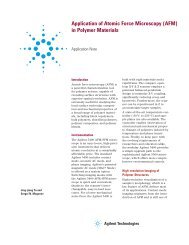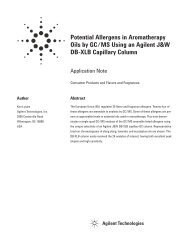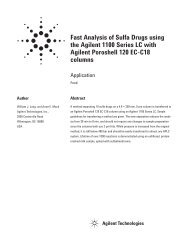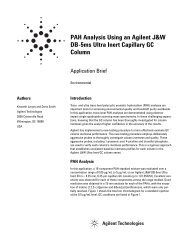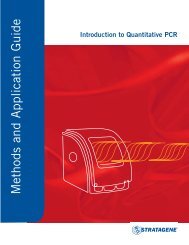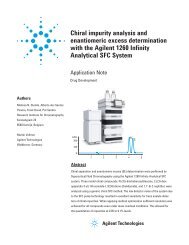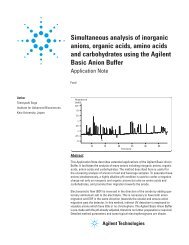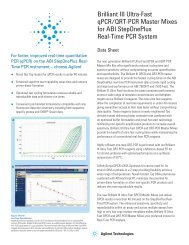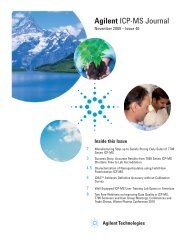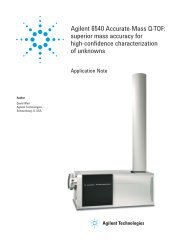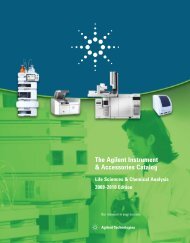Agilent BioSeparations Selection Guide
Agilent BioSeparations Selection Guide
Agilent BioSeparations Selection Guide
Create successful ePaper yourself
Turn your PDF publications into a flip-book with our unique Google optimized e-Paper software.
<strong>Agilent</strong> <strong>BioSeparations</strong> <strong>Selection</strong> <strong>Guide</strong>
Reversed Phase HPLC BioColumns ............................................................. 4<br />
Poroshell 300 ..................................................................................................................................... 8<br />
ZORBAX 300Å StableBond ............................................................................................................ 10<br />
ZORBAX 300Å Extend-C18 ............................................................................................................ 14<br />
Bio-Monolith HPLC Columns...................................................................... 17<br />
ZORBAX Size Exclusion Columns .............................................................. 21<br />
ZORBAX GF-250 and GF-450 Gel Filtration Columns ................................................................ 21<br />
ZORBAX Capillary, Nano and MicroBore Columns.................................. 23<br />
ZORBAX Capillary and Nano ......................................................................................................... 23<br />
ZORBAX MicroBore (1.0 mm ID) .................................................................................................. 25<br />
Custom HPLC Column Ordering ................................................................................................... 26<br />
Proteomic Columns and Accessories........................................................ 27<br />
Multiple Affinity Removal System ............................................................................................... 27<br />
Multiple Affinity Removal System Starter Kits .......................................................................... 28<br />
mRP-C18 High Recovery Protein Columns ................................................................................. 29<br />
<strong>Agilent</strong> 3100 OFFGEL Fractionator ............................................................................................... 30<br />
2
<strong>Agilent</strong> Columns and Supplies<br />
for <strong>BioSeparations</strong><br />
From sample simplification to analysis, <strong>Agilent</strong>’s BioSeparation tools can<br />
be integrated into your workflow for a complete solution that provides<br />
reproducible and high-quality results.<br />
In this new guide, you will find everything from selection guides to product<br />
features and columns specifications. You’ll also find comprehensive guides<br />
to help you order top-quality <strong>Agilent</strong> columns and supplies, which have over<br />
40 years of technical experience built right in.<br />
So whether you are characterizing monoclonal antibodies with a StableBond<br />
300SB column or monitoring your process scale purifications with a<br />
Bio-Monolith column, <strong>Agilent</strong> has a complete solution to meet your needs.<br />
Learn more about <strong>Agilent</strong>'s <strong>BioSeparations</strong> solutions<br />
at Solution Source!<br />
Solution Source for <strong>BioSeparations</strong> is your online resource for easy<br />
access to the latest applications, product information, special offers,<br />
learning opportunities, and upcoming events. Visit Solution Source<br />
today at www.agilent.com/chem/ssbiocolumns.<br />
3
Reversed Phase HPLC BioColumns<br />
ZORBAX Strategy for Reversed-Phase Method<br />
Development of Proteins and Peptides<br />
This ZORBAX Column <strong>Selection</strong> Strategy for Proteins and Peptides provides some critical details on method development for proteins or<br />
polypeptides. For small peptides, Molecular Weight < 2000, please follow the method development strategy for small and large molecules in<br />
the reference section of this guide. For efficient separations of large molecules, columns with a wide-pore size (300Å) are required. For method<br />
development of larger peptides and proteins, review the suggested guidelines outlined below. Wide-pore column choices are described in the<br />
following section of this Column <strong>Selection</strong> <strong>Guide</strong>.<br />
Choose the Initial Column and Conditions for Proteins and Peptides<br />
Peptides, Polypeptides, Proteins<br />
MW < 50 kDA<br />
Peptides, Polypeptides, Proteins<br />
MW < 1,000 kDA<br />
Initial Bonded Phase Choice<br />
StableBond 300SB-C8<br />
300SB columns are wide-pore columns with unbeatable lifetime<br />
in TFA-containing mobile phases. This makes them an ideal first<br />
choice for separations of peptides and proteins.<br />
• C8 is an excellent starting bonded phase because of its<br />
moderate hydrophobicity.<br />
• C18 and C8 are generally selected for peptides and protein<br />
digests but can also be used for proteins.<br />
• C3, C4 and CN are generally selected for larger, hydrophobic<br />
polypeptides and proteins but can also be used for peptides.<br />
Poroshell 300SB-C18<br />
Poroshell 300SB columns use an innovative particle technology<br />
to deliver rapid protein separations. Short analysis times with<br />
efficient peaks are easily obtained with Poroshell columns.<br />
• C18 is a good starting bonded phase choice with Poroshell<br />
for most peptides, polypeptides and proteins because the<br />
retention is maximized.<br />
• C8 is generally selected for moderate size proteins but can<br />
be used with polypeptides or very large proteins.<br />
• C3 is generally selected for antibodies or large proteins but<br />
can be used for peptides and polypeptides.<br />
Initial Separation Conditions<br />
Column: StableBond 300SB-C8<br />
4.6 x 150 mm, 3.5 or 5 μm<br />
883995-906<br />
863973-906<br />
Mobile Phase: A: 95% H 2 O:5% ACN with 0.1% TFA<br />
B: 5% H 2 O:95% ACN with 0.085% TFA<br />
Gradient: 0-60% B in 60 min<br />
Temperature: 35-40°C<br />
Flow Rate: 1 mL/min<br />
Column:<br />
Poroshell 300SB-C18<br />
2.1 x 75 mm, 5 μm<br />
660750-902<br />
Mobile Phase: A: 95% H 2 O:5% ACN with 0.1% TFA<br />
B: 5% H 2 O:95% ACN with 0.085% TFA<br />
Gradient: 0-60% B in 10 min<br />
Temperature: 35-40°C<br />
Flow Rate: 2 mL/min<br />
4
Reversed Phase HPLC BioColumns<br />
Start at low pH with simple aqueous/organic gradient<br />
Typically a Water/Acetonitrile with 0.1% TFA gradient is used to elute all components of interest.<br />
A typical high resolution gradient on a 300Å pore size column requires 30-50 min. A Poroshell column<br />
requires a shorter analysis time and a higher flow rate and still provides exceptional resolution.<br />
To improve resolution, increase the gradient time, decrease column length, or increase flow rate.<br />
Optimize sample solubility<br />
For best peak shape and recovery at any pH, it is important to solubilize a sample completely. Highly<br />
acidic or neutral solvents can be used with ZORBAX 300StableBond and Poroshell 300SB, while neutral<br />
solvents and dilute bases can be used with ZORBAX 300Extend-C18.<br />
Solvent Choices to Solubilize Proteins and Peptides<br />
Water/Phosphate Buffer<br />
Dilute Acid (TFA, Acetic Acid or HCl)<br />
Neutral pH, 6-8 M Guanidine-HCl or Isothiocyanate<br />
5% HOAc/6 M Urea<br />
Dilute Acid + Aqueous/Organic Solvents (ACE, MeOH, THF)<br />
Dilute Base (Ammonioum Hydroxide)<br />
DMSO or 0.1%-1% TFA in DMSO<br />
Formamide<br />
StableBond 300SB – up to 80°C Poroshell 300SB – up to 80°C<br />
Weakest<br />
Strongest<br />
Raise the Temperature<br />
Separations of proteins and peptides are influenced by temperature and higher column temperature can<br />
dramatically improve both resolution and recovery of proteins and hydrophobic and aggregating peptides.<br />
Optimize Mobile Phase pH<br />
Try mid and high pH if low pH does not work<br />
If an optimized low pH method does not provide an ideal separation, then mid or high pH mobile phase<br />
can be used. At high pH selectivity is often very different because acidic amino acids become negatively<br />
charged and some basic amino acids may lose their charge. ZORBAX 300Extend-C18 is an excellent<br />
choice for mid to high pH separation.<br />
Column:<br />
Mobile Phase:<br />
Gradient:<br />
Temperature:<br />
Flow Rate:<br />
300Extend-C18<br />
4.6 x 150 mm, 5 μm<br />
773995-902<br />
A: 20 mM NH 4 OH in H 2 O<br />
B: 20 mM NH 4 OH in 80% ACN<br />
5-60% B in 30 minutes<br />
25-30°C (
Reversed Phase HPLC BioColumns<br />
Starting Column Choices for Analytical Separations<br />
of Peptides, Polypeptides, and Proteins<br />
Low pH<br />
Mid and High pH<br />
MW < 50 kDa<br />
300SB-C8<br />
4.6 x 150 mm, 3.5 μm<br />
863973-906<br />
MW < 1000 kDa<br />
Poroshell 300SB-C18<br />
2.1 x 75 mm, 5 μm<br />
660750-902<br />
MW < 25 kDa<br />
300Extend-C18<br />
4.6 x 150 mm, 3.5 μm<br />
763973-902<br />
Separations of Proteins and Peptides Using<br />
Reversed-Phase LC/MS Methods<br />
LC/MS of proteins and peptides is used to provide information for protein characterization, to accurately identify post-translational<br />
modifications of proteins, and to determine the molecular weight of synthetic and natural peptides. LC/MS is used to provide protein<br />
identification in 2D separations for proteomics applications. Therefore, LC/MS of proteins and peptides is a critical separation area, which<br />
requires some special column and mobile phase recommendations. In general, smaller column sizes are used for LC/MS and TFA is generally<br />
not used in mobile phase because of reduced sensitivity in the MS with this mobile phase additive.<br />
Initial Column Choices for LC/MS Separations of Proteins and Polypeptides<br />
Analytical LC/MS Applications – 2.1 mm ID columns will provide<br />
good sensitivity when sample size is not limited.<br />
With Poroshell columns, smaller column IDs are used.<br />
Low pH<br />
Mid and High pH<br />
MW < 50 kDa<br />
300SB-C8<br />
2.1 x 150 mm, 3.5 μm<br />
863750-906<br />
MW < 1000 kDa<br />
Poroshell 300SB-C18<br />
1.0 x 75 mm, 5 μm<br />
661750-902<br />
MW < 25 kDa300<br />
2.1 x 150 mm, 3.5 μm<br />
763750-902<br />
High Sensitivity/Proteomics Applications<br />
Capillary columns are used for high sensitivity protein and peptide applications. The 0.5 mm ID columns are used for protein and protein digest<br />
separations while the 0.3 mm ID columns are most often used for protein digests. These can be analyzed at high pH with an ammonium<br />
hydroxide mobile phase. Nano columns (0.1 and 0.075 mm ID) are often used in 2D LC/MS systems for proteomics and the initial choice is a<br />
C18 bonded phase.<br />
6
Reversed Phase HPLC BioColumns<br />
High Sensitivity Capillary Columns<br />
Low pH<br />
Mid and High pH<br />
MW < 50 kDa<br />
300SB-C18<br />
0.5 x 150 mm, 3.5 μm<br />
5064-8268<br />
MW < 1000 kDa<br />
Poroshell 300SB-C8<br />
0.5 x 74 mm, 5 μm<br />
5065-4468<br />
MW < 25 kDa<br />
300Extend-C18<br />
0.3 x 150 mm, 3.5 μm<br />
5065-4464<br />
Nano Columns for Proteomics/2-D LC/MS<br />
SCX (1st Dimension)<br />
0.3 x 35 mm, 5 μm<br />
5065-9912<br />
Reversed-Phase (2nd Dimension)<br />
0.075 x 150 mm, 3.5 μm<br />
5065-9911<br />
Mobile Phase Considerations<br />
Low pH<br />
Mid and High pH<br />
TFA is generally not used for LC/MS separations of<br />
proteins and peptides. The first step is normally to<br />
replace TFA with 0.1-1.0% formic acid. Acetic acid, up to<br />
1%, can also be used as an alternative mobile phase<br />
modifier. At low pH, the best separation may still be<br />
obtained with TFA in the mobile phase. In some cases,<br />
the TFA can be displaced post column with an alternate<br />
acid, such as propionic acid.<br />
LC/MS can also be done at high pH with<br />
10-20 mM NH 4 OH as a mobile phase additive.<br />
7
Reversed Phase HPLC BioColumns<br />
Porous Shell<br />
SOLID<br />
CORE<br />
5 μm<br />
Poroshell 300<br />
• High-resolution separations of biomolecules with superficially porous particles<br />
• High efficiency and recovery with proteins (up to 1,000 kDa) and monoclonal antibodies<br />
• Achieve long lifetime at low pH with Poroshell 300SB; at high pH with 300Extend-C18<br />
• Optimize recovery and selectivity with four different bonded phases – 300SB-C18,<br />
300SB-C8, 300SB-C3, and 300Extend-C18<br />
<strong>Agilent</strong> Poroshell 300 columns are ideal for fast separations of proteins and peptides because<br />
the superficially porous particle allows for fast flow rates to be used while maintaining sharp,<br />
efficient peaks. Peptides and proteins are typically separated slowly to reduce the potential<br />
peak broadening of these slow diffusing analytes. But Poroshell columns use a superficially<br />
porous particle made with a thin layer of porous silica on a solid core of silica. This reduces<br />
the diffusion distance for proteins making practical rapid HPLC separations of peptides and<br />
proteins up to 500-1,000 kDA. Poroshell columns bonded with StableBond bonded phases<br />
provide excellent stability and selectivity choices with TFA and formic acid mobile phases.<br />
The Poroshell 300Extend-C18 column can be used from pH 2-10 for unique separations.<br />
These columns can be used for analytical protein separations as well as LC/MS separations.<br />
Column Specifications<br />
Bonded Phase Pore Size Temp. Limits* pH Range Endcapped<br />
Poroshell 300SB-C18, C8, C3 300Å 90°C 1.0-8.0 No<br />
Poroshell 300Extend 300Å 40°C above pH 8 2.0-11.0 Yes<br />
60°C below pH 8<br />
Specifications represent typical values only.<br />
Poroshell 300<br />
Description Size (mm) Particle<br />
Size (μm)<br />
Poroshell<br />
300SB-C18<br />
Poroshell<br />
300SB-C8<br />
Poroshell<br />
300SB-C3<br />
Poroshell<br />
300Extend-C18<br />
Narrow Bore 2.1 x 75 5 660750-902 660750-906 660750-909 670750-902<br />
MicroBore 1.0 x 75 5 661750-902 661750-906 661750-909 671750-902<br />
Capillary 0.5 x 75 5 5065-4468<br />
Guard Cartridge, 4/pk 2.1 x 12.5 5 821075-920 821075-918 821075-924<br />
Guard Hardware Kit 820888-901 820888-901 820888-901<br />
MicroBore Guard, 3/pk 1.0 x 17 5 5185-5968 5185-5968 5185-5968 5185-5968<br />
8
Reversed Phase HPLC BioColumns<br />
Monoclonal IgG1 Chains: Separation on Poroshell 300SB-C8<br />
Column: Poroshell 300SB-C8<br />
660750-906<br />
2.1 x 75 mm, 5 μm<br />
Mobile Phase: A: 90% water: 10% ACN + 3 mL/L of MW 300 PEG<br />
B: 10% water: 90% ACN + 3 mL/L of MW 300 PEG<br />
Flow Rate: 1.0 mL/min<br />
Gradient: 0 min 25% B<br />
10 min 40% B<br />
10.1 min 25% B<br />
12 min 25% B<br />
Temperature: 70°C<br />
Sample: Monoclonal IgG1<br />
Light Chains<br />
Glycosylated Heavy Chains<br />
A: Treated with DTT<br />
Courtesy of:<br />
Novartis Pharma,<br />
Biotechnology, Basel<br />
Dr. Kurt Forrer<br />
Patrik Roethlisberger<br />
0 2<br />
4<br />
6 8 10<br />
B: Treated with DTT Peptide-N-Glycosidase F<br />
0 2<br />
4<br />
6 8 10<br />
C: Treated with DTT Peptide-N-Glycosidase<br />
F Carboxypeptidase -B<br />
0 2<br />
4<br />
6 8 10<br />
Time (min)<br />
LCBP015<br />
9
Reversed Phase HPLC BioColumns<br />
ZORBAX 300Å StableBond<br />
<strong>Agilent</strong> ZORBAX 300StableBond columns are an ideal choice for the reproducible separations<br />
of proteins and peptides for two key reasons. First, wide-pore, 300Å columns are necessary<br />
for an efficient separation of proteins and peptides, or other large molecules, in order to allow<br />
these analytes to completely access the bonded phase. Second, 300StableBond columns are<br />
unmatched in their durability at low pH, such as with the TFA containing mobile phases<br />
typically used for protein and peptide separations. For LC/MS separations at low pH,<br />
300StableBond columns can also be used with formic acid and acetic acid mobile phase<br />
modifiers. These columns are available in four different bonded phases (C18, C8, C3, and CN)<br />
for selectivity and recovery optimization of proteins and polypeptides. To further increase<br />
sample recovery and improve efficiency for difficult proteins, 300StableBond columns can<br />
be used up to 80-90°C. 300SB-C18 and 300SB-C8 columns are an ideal choice for complex<br />
protein and protein digest separations. These columns are available in capillary (0.3, 0.5 mm ID)<br />
and nano (0.075 and 0.10 mm ID) dimensions for reversed-phase LC/MS separations<br />
of these protein digests. Capillary and nano columns can be used for either 1D or 2D<br />
proteomics separations.<br />
Column Specifications<br />
Bonded Phase<br />
Pore<br />
Size<br />
Surface<br />
Area<br />
Temp.<br />
Limits*<br />
pH Range* Endcapped Carbon<br />
Load<br />
O<br />
OH<br />
R<br />
Si<br />
R<br />
R<br />
R 1<br />
ZORBAX 300SB-C18 300Å 45 m 2 /g 90°C 1.0-8.0 No 2.8%<br />
ZORBAX 300SB-C8 300Å 45 m 2 /g 80°C 1.0-8.0 No 1.5%<br />
ZORBAX 300SB-C3 300Å 45 m 2 /g 80°C 1.0-8.0 No 1.1%<br />
ZORBAX 300SB-CN 300Å 45 m 2 /g 80°C 1.0-8.0 No 1.2%<br />
*300StableBond columns are designed for optimal use at low pH. At pH 6-8, highest column stability for all<br />
silica-based columns is obtained by operating at temperatures
Reversed Phase HPLC BioColumns<br />
ZORBAX 300Å StableBond<br />
Description Size (mm) Particle<br />
Size (μm)<br />
300SB-C18<br />
USP L1<br />
300SB-C8<br />
USP L7<br />
300SB-CN<br />
USP L10<br />
300SB-C3<br />
USP L56<br />
Standard Columns (no special hardware required)<br />
Semi-Preparative 9.4 x 250 5 880995-202 880995-206 880995-205 880995-209<br />
Analytical 4.6 x 250 5 880995-902 880995-906 880995-905 880995-909<br />
Analytical 4.6 x 150 5 883995-902 883995-906 883995-905 883995-909<br />
Analytical 4.6 x 50 5 860950-902 860950-906 860950-905 860950-909<br />
Rapid Resolution 4.6 x 150 3.5 863973-902 863973-906 863973-905 863973-909<br />
Rapid Resolution 4.6 x 100 3.5 861973-902 861973-906<br />
Rapid Resolution 4.6 x 50 3.5 865973-902 865973-906 865973-905 865973-909<br />
Solvent Saver Plus 3.0 x 150 3.5 863974-302 863974-306 863974-309<br />
Solvent Saver Plus 3.0 x 100 3.5 861973-306<br />
Narrow Bore 2.1 x 250 5 881750-902<br />
Narrow Bore 2.1 x 150 5 883750-902 883750-906 883750-905 883750-909<br />
Narrow Bore RR* 2.1 x 150 3.5 863750-906<br />
Narrow Bore RR* 2.1 x 100 3.5 861775-902 861775-906<br />
Narrow Bore RR* 2.1 x 50 3.5 865750-902 865750-906<br />
MicroBore 1.0 x 250 5 861630-902<br />
MicroBore RR* 1.0 x 150 3.5 863630-902 863630-906<br />
MicroBore RR* 1.0 x 50 3.5 865630-902 865630-906<br />
MicroBore Guard, 3/pk 1.0 x 17 5 5185-5920 5185-5920<br />
Guard Cartridge, 2/pk 9.4 x 15 7 820675-124 820675-124 820675-124 820675-124<br />
Guard Cartridge, 4/pk 4.6 x 12.5 5 820950-921 820950-918 820950-923 820950-924<br />
Guard Cartridge, 4/pk 2.1 x 12.5 5 821125-918 821125-918 821125-924 821125-924<br />
Guard Hardware Kit 840140-901 840140-901 840140-901 840140-901<br />
Guard Hardware Kit 820888-901 820888-901 820888-901 820888-901<br />
11
Reversed Phase HPLC BioColumns<br />
ZORBAX 300Å StableBond<br />
Description Size (mm) Particle<br />
Size (μm)<br />
300SB-C18<br />
USP L1<br />
300SB-C8<br />
USP L7<br />
300SB-CN<br />
USP L10<br />
300SB-C3<br />
USP L56<br />
PrepHT Cartridge Columns (require endfittings kit 820400-901)<br />
PrepHT Cartridge 21.2 x 250 7 897250-102 897250-106 897250-105 897250-109<br />
PrepHT Cartridge 21.2 x 150 7 897150-102 897150-106 897150-109<br />
PrepHT Cartridge 21.2 x 150 5 895150-902 895150-906 895150-909<br />
PrepHT Cartridge 21.2 x 100 5 895100-902 895100-906 895100-909<br />
PrepHT Cartridge 21.2 x 50 5 895050-902 895050-906 895050-909<br />
PrepHT endfittings, 2/pk 820400-901 820400-901 820400-901 820400-901<br />
PrepHT Guard Cartridge, 2/pk 17 x 7.5 5 820212-921 820212-918 820212-924 820212-924<br />
Guard Cartridge Hardware 820444-901 820444-901 820444-901 820444-901<br />
Capillary Glass-lined Columns<br />
Capillary 0.5 x 250 5 5064-8266<br />
Capillary 0.5 x 150 5 5064-8264<br />
Capillary 0.5 x 35 5 5064-8294<br />
Capillary RR* 0.5 x 150 3.5 5064-8268<br />
Capillary RR* 0.5 x 35 3.5 5065-4459<br />
Capillary 0.3 x 250 5 5064-8265<br />
Capillary 0.3 x 150 5 5064-8263<br />
Capillary 0.3 x 35 5 5064-8295<br />
Capillary RR* 0.3 x 150 3.5 5064-8267 5065-4460<br />
Capillary RR* 0.3 x 100 3.5 5064-8259 5065-4461<br />
Capillary RR* 0.3 x 50 3.5 5064-8300 5065-4463<br />
Capillary RR* 0.3 x 35 3.5 5064-8270 5065-4462<br />
Nano Columns (PEEK fused silica)<br />
Nano RR* 0.1 x 150 3.5 5065-9910<br />
Nano RR* 0.075 x 150 3.5 5065-9911<br />
Nano RR* 0.075 x 50 3.5 5065-9924 5065-9923<br />
Trap/Guard, 5/pk 0.3 x 5 5 5065-9913 5065-9914<br />
Trap/Guard Hardware kit 5065-9915 5065-9915<br />
*RR: Rapid Resolution 3.5 μm<br />
12
Reversed Phase HPLC BioColumns<br />
Peptides/Proteins: Equivalent Gradient Separations<br />
Column A:<br />
Column B:<br />
Mobile Phase:<br />
Flow Rate:<br />
ZORBAX 300SB-C8<br />
883995-906<br />
4.6 x 150 mm, 5 μm<br />
ZORBAX 300SB-C8<br />
883750-906<br />
2.1 x 150 mm, 5 μm<br />
A: 95% Water: 5% ACN with 0.1% TFA<br />
B: 5% Water: 95% ACN with 0.085% TFA<br />
a: Analytical<br />
1 mL / min<br />
b: Narrow Bore<br />
0.2 mL / min<br />
A<br />
B<br />
1 2 34<br />
5<br />
2<br />
1 5<br />
3 4<br />
6<br />
6<br />
7<br />
7<br />
9<br />
10<br />
8<br />
9<br />
10<br />
8<br />
1. Met-enkephalin<br />
2. Leu-enkephalin<br />
3. Angiotensin II<br />
4. Neurontensin<br />
5. RNase<br />
6. Insulin (BOV)<br />
7. Lysozyme<br />
8. Calmodulin<br />
9. Myoglobin<br />
10. Carbonic anhydrase<br />
Gradient: 10-60% B in 30 min.<br />
Temperature: 35°C<br />
LCBP024<br />
Detector:<br />
UV 215 nm<br />
Sample:<br />
10 μL injection, Concentration 2-6 μg<br />
Proteins: Effect of Bonded Phase, RP<br />
Column A: ZORBAX 300SB-C8<br />
883995-906<br />
4.6 x 150 mm, 5 μm<br />
Column B: ZORBAX 300SB-CN<br />
883995-905<br />
0.21<br />
4.6 x 150 mm, 5 μm<br />
Mobile Phase: A: 0.1% TFA in Water,<br />
B: 0.1% TFA in 50/50<br />
ACN/Water<br />
0.15<br />
0.09<br />
Flow Rate: 1.0 mL/min<br />
Gradient: 1. 46-96% B in 60 min.<br />
23-48% ACN<br />
0.03<br />
2. 50-86%B in 60 min.<br />
25-43% ACN<br />
Temperature: 50°C<br />
Detector: UV 210 nm<br />
Sample: Wheat Proteins, including w-gliadins<br />
Absorbance, 210 nm, mv x 10 3<br />
A<br />
1.<br />
10<br />
-gliadins<br />
0 20 40 60<br />
Time (min)<br />
9<br />
5<br />
7*<br />
2*<br />
0.50<br />
0.35<br />
0.20<br />
0.05<br />
B<br />
2.<br />
5<br />
7*<br />
-gliadins<br />
10 9<br />
0 20 40 60<br />
Time (min)<br />
2*<br />
LCBP038<br />
13
Reversed Phase HPLC BioColumns<br />
ZORBAX 300Å Extend-C18<br />
• Rugged, high and low pH separations of polypeptides and peptides from pH 2-11.5<br />
• Different selectivity possible at high and low pH<br />
• High efficiency and good recovery of hydrophobic peptides at high pH<br />
• Ideal for LC/MS with ammonium hydroxide-modified mobile phase<br />
O<br />
O<br />
Si<br />
Si<br />
C18<br />
C18<br />
<strong>Agilent</strong> ZORBAX 300Extend C-18 is a wide-pore HPLC column for high efficiency separations<br />
of peptides from pH 2-11.5. The unique, bidentate bonded phase provides excellent lifetime<br />
and reproducibility at high and low pH. At high pH, retention and selectivity of peptides and<br />
polypeptides can change dramatically as a result of changes in charge on molecules.<br />
Excellent recoveries of hydrophobic polypeptides have been achieved at room temperature<br />
and high pH. LC/MS sensitivity of peptides and polypeptides can also be improved at high pH<br />
using a simple ammonium hydroxide-containing mobile phase.<br />
Silica Support<br />
Novel Bidentate C18-C18 Bonding<br />
for Extend-C18 Bonded Phase<br />
Column Specifications<br />
Bonded Phase<br />
Pore<br />
Size<br />
Surface<br />
Area<br />
Temp.<br />
Limits*<br />
pH Range Endcapped Carbon<br />
Load<br />
ZORBAX 300Extend-C18 300Å 45 m 2 /g 60°C 2.0-11.5 Double 4%<br />
*Temperature limits are 60°C up to pH 8, 40°C from pH 8-11.5.<br />
14
Reversed Phase HPLC BioColumns<br />
ZORBAX 300Å Extend-C18<br />
Description Size (mm) Particle<br />
Size (μm)<br />
Part No.<br />
Analytical 4.6 x 250 5 770995-902<br />
Analytical 4.6 x 150 5 773995-902<br />
Rapid Resolution 4.6 x 150 3.5 763973-902<br />
Rapid Resolution 4.6 x 100 3.5 761973-902<br />
Rapid Resolution 4.6 x 50 3.5 765973-902<br />
Narrow Bore RR* 2.1 x 150 3.5 763750-902<br />
Narrow Bore RR* 2.1 x 100 3.5 761775-902<br />
Narrow Bore RR* 2.1 x 50 3.5 765750-902<br />
Guard Cartridge, 4/pk 4.6 x 12.5 5 820950-932<br />
Guard Cartridge, 4/pk 2.1 x 12.5 5 821125-932<br />
Guard Hardware Kit 820888-901<br />
Capillary Glass-lined Columns<br />
Capillary RR* 0.3 x 150 3.5 5065-4464<br />
Capillary RR* 0.3 x 100 3.5 5065-4465<br />
Capillary RR* 0.3 x 75 3.5 5065-4466<br />
Capillary RR* 0.3 x 50 3.5 5065-4467<br />
*RR: Rapid Resolution 3.5 μm<br />
15
Reversed Phase HPLC BioColumns<br />
Long Life at High pH with 300Extend-C18<br />
Column: ZORBAX Extend-C18<br />
773450-902<br />
4.6 x 150 mm, 5 μm<br />
Mobile Phase: 20% 20 mM NH 4 OH, pH 10.5<br />
80% Methanol<br />
Flow Rate: 1.5 mL/min<br />
Temperature: Aging 24°C<br />
Tests 40°C<br />
8<br />
6<br />
4-Chloro-1-nitrobenzene<br />
Trimipramine<br />
k Values<br />
4<br />
2<br />
Each 10,000 column volume is approximately one<br />
working month.<br />
0<br />
0 10,000 20,000 30,000 40,000 50,000<br />
Column Volumes of Mobile Phase<br />
LC30001<br />
16
Bio-Monolith HPLC Columns<br />
<strong>Agilent</strong> Bio-Monolith HPLC Columns<br />
• Polymer-based, monolith HPLC columns designed for macro bio-molecule separations<br />
• Flow rate independent separations; no diffusion, no pores and no void volume make<br />
transport between mobile and stationary phase very rapid<br />
• Monolith disc is 5.2 mm x 4.95 mm (100 μL column volume) with continuous channels,<br />
eliminating diffusion mass transfer<br />
• Extremely fast separations speed up method development time and decrease costs.<br />
Locking in method parameters takes significantly less time and buffer.<br />
<strong>Agilent</strong> Bio-Monolith HPLC columns provide high resolution and rapid separations of<br />
antibodies (IgG, IgM), plasmid DNA, viruses, phages and other macro bio-molecules.<br />
The product family offers strong cation exchange, strong and weak anion exchange and<br />
Protein A phases. Bio-Monolith HPLC Columns are compatible with HPLC and preparative<br />
LC systems, including <strong>Agilent</strong> 1100 and 1200 HPLC systems.<br />
Column Specifications<br />
Dimensions<br />
5.2 mm x 4.95 mm<br />
Column volume<br />
100 μL<br />
Maximum pressure<br />
150 bar (15 MPa, 2200 psi)<br />
Temperature min/max<br />
Working: 4°C-40°C (39°F-122°F)<br />
Storage: 4°C-30°C (39°F-73°F)<br />
Recommended pH Working range: 2-13<br />
Cleaning-in-place: 1-14<br />
Materials of construction Hardware: Stainless steel<br />
Packing: poly (glycidyl methacrylate-co-ethylene dimethacrylate)<br />
highly porous monolith<br />
Color ring identifier<br />
Bio-Monolith QA: Blue<br />
Bio-Monolith DEAE: Green<br />
Bio-Monolith SO 3 : Red<br />
Bio-Monolith Protein A: White<br />
Shelf life/expiration date Protein A: 12 months<br />
SO 3 , QA, DEAE: 24-36 months<br />
17
Bio-Monolith HPLC Columns<br />
<strong>Agilent</strong> Bio-Monolith HPLC Column <strong>Selection</strong> <strong>Guide</strong><br />
Column Description Key Applications Part No.<br />
Bio-Monolith QA<br />
Bio-Monolith DEAE<br />
Bio-Monolith SO 3<br />
Bio-Monolith Protein A<br />
The quaternary amine bonded phase (Strong<br />
Anion Exchange) is fully charged over a<br />
working pH range of 2-13, binding negatively<br />
charged bio-molecules.<br />
The diethylaminoethyl bonded phase<br />
(Weak Anion Exchange) offers increased<br />
selectivity of bio-molecules with negative<br />
charge over a working pH range of 3-9.<br />
The sulfonyl bonded phase (Strong Cation<br />
Exchange) is fully charged over a working<br />
pH range of 2-13, binding positively charged<br />
bio-molecules.<br />
The Protein A affinity column is designed for<br />
the analytical separation of all IgG (human<br />
and mouse), except for IgG class3.<br />
Adenovirus process monitoring<br />
and quality control<br />
IgM purification monitoring<br />
and quality control<br />
Monitoring DNA impurity removal<br />
Monitoring endotoxin removal<br />
HSA Purity<br />
Process monitoring and quality control<br />
of bacteriophage manufacturing<br />
and purification<br />
Process monitoring and quality control<br />
of plasmid DNA purification<br />
Fast and high resolution analytical<br />
separations of large molecules such as<br />
proteins, antibodies<br />
Hemoglobin A1c fast analytics<br />
Quantitative Determination of IgG<br />
(fermentation titer calculation)<br />
5069-3635<br />
5069-3639<br />
5069-3637<br />
5069-3639<br />
18
Bio-Monolith HPLC Columns<br />
Bio-Monolith DEAE Column Monitors Phage Production<br />
During Fermentation<br />
Column: DEAE<br />
5069-3636<br />
2 x 4 mm<br />
Mobile Phase: A: 125 mM Phosphate buffer, pH 7.0<br />
B: 125 mM Phosphate buffer + 1M NaCl, pH 7.0<br />
Flow Rate: 1 mL/min<br />
Gradient: 100% buffer A (2.5 min)<br />
0-100% buffer B (10 min)<br />
100% buffer A (2 min)<br />
Detector: UV at 280 nm<br />
Instrument: High pressure gradient HPLC system, <strong>Agilent</strong> 1200<br />
50<br />
120<br />
Relative Absorbance (mAU)<br />
45<br />
40<br />
35<br />
30<br />
25<br />
20<br />
15<br />
10<br />
5<br />
Phages and<br />
other components<br />
Time 36 min<br />
Time 158 min<br />
Time 191 min<br />
% Buffer B<br />
1<br />
3<br />
2<br />
100<br />
80<br />
60<br />
40<br />
20<br />
% Gradient<br />
0<br />
0 2 4 6 8 10 12<br />
Time (min)<br />
0<br />
As phage proliferation progresses, the genomic DNA (gDNA) concentration increases<br />
as the host cells are being lysed. In the late stages of fermentation gDNA begins to<br />
degrade into fragments. These gDNA fragments cannot be easily removed by<br />
purification media so, it is critical to stop the fermentation cycle prior to the degradation<br />
of the genomic DNA. The chromatogram above represents three samples taken from the<br />
bioreactor at time 36 min, 158 min and 191 min. Peak 1 represents phage, media and<br />
host cells, peak 2 the intact gDNA and peak 3 the fragmented gDNA.<br />
19
Bio-Monolith HPLC Columns<br />
Bio-Monolith Protein A Column Rapidly Monitors IgG Fermentation Titers<br />
Column:<br />
Protein A<br />
5069-3636<br />
2 x 4 mm<br />
240<br />
Mobile Phase: A: 1x PBS, pH 7.0<br />
B: 0.5 M acetic acid, pH 2.6<br />
Flow Rate: 1 mL/min<br />
Gradient: 100% buffer A<br />
100% buffer B<br />
100% buffer A<br />
(0.5 min each step)<br />
Relative absorbance (mAU)<br />
190<br />
140<br />
90<br />
2 mL/min<br />
1mL/min<br />
Detector:<br />
Instrument:<br />
UV at 280 nm<br />
High pressure gradient<br />
HPLC system, <strong>Agilent</strong> 1200<br />
40<br />
_ 10<br />
Time (min)<br />
An IgG standard was measured at two flow rates, 1 mL/min and 2 mL/min, which<br />
correspond to 10 column volumes/min and 20 column volumes/min, respectively. The<br />
concentration of IgG in the sample can be reliably obtained within minutes.<br />
1600<br />
1400<br />
The calibration curve<br />
1200<br />
Peak area<br />
1000<br />
800<br />
600<br />
y = 728.55x<br />
R 2 = 0.9975<br />
400<br />
200<br />
0<br />
C (mg/mL)<br />
The above calibration curve results from a 2-fold dilution series of human IgG<br />
concentrate. The initial IgG concentration was 2 mg/mL. IgG peak areas were<br />
integrated and plotted. The linear range of the assay easily covers the production<br />
ranges necessary to accommodate development and manufacturing cell cultures.<br />
20
ZORBAX Size Exclusion Columns<br />
ZORBAX GF-250 and GF-450 Gel<br />
Filtration Columns<br />
• High efficiency and reproducibility with short analysis time<br />
• Hydrophilic diol bonded phase for good protein recovery<br />
• Compatible with organic modifiers and denaturants<br />
• Wide usable pH range (pH 3-8)<br />
<strong>Agilent</strong> ZORBAX GF-250 and GF-450 size exclusion (gel filtration) columns are ideal for the size<br />
separations of proteins and other biomolecules. The separation range is 4,000-900,000 for<br />
globular proteins when using GF-250 and GF-450 columns in series. The GF-250/GF-450 size<br />
exclusion columns have a hydrophilic diol bonded phase for high recovery of proteins (typically<br />
>90%) and a unique zirconia modification of the silica to extend the pH range from 3-8. The<br />
GF-250 and GF-450 columns are packed with precisely sized porous silica microspheres with<br />
narrow pore size and particle size distributions. The result is a highly efficient, rugged and<br />
reproducible size exclusion column for separations of proteins with flow rates of up to 3 mL/min.<br />
These columns are compatible with organic modifiers (
ZORBAX Size Exclusion Columns<br />
ZORBAX GF-250 and GF-450 Gel Filtration Columns<br />
Description<br />
Size (mm) Particle<br />
Size (μm)<br />
Part No.<br />
GF-250, 150Å 9.4 x 250 4 884973-901<br />
GF-250, 150Å 4.6 x 250 4 884973-701<br />
GF-450, 300Å 9.4 x 250 6 884973-902<br />
Guard Columns (hardware required)<br />
GF-250 Diol, Guard Cartridge, 2/pk 9.4 x 15 6 820675-111<br />
GF-250 Diol, Guard Cartridge, 4/pk 4.6 x 12.5 6 820950-911<br />
GF-450 Diol, Guard Cartridge, 2/pk 9.4 x 15 6 820675-111<br />
GF-250 Diol, Guard Cartridge, 4/pk 4.6 x 12.5 6 820950-911<br />
Guard Hardware Kit 840140-901<br />
Guard Hardware Kit 820888-901<br />
PrepHT Columns<br />
PrepHT GF-250, 150Å 21.2 x 250 6 877974-901<br />
PrepHT GF-450, 300Å 21.2 x 250 6 877974-910<br />
PrepHT endfittings, 2/pk 820400-901<br />
PrepHT GF-250, Guard Cartridge, 2/pk 17 x 7.5 6 820212-911<br />
PrepHT GF-450, Guard Cartridge, 2/pk 17 x 7.5 6 820212-911<br />
Guard Cartridge Hardware 820444-901<br />
22
ZORBAX Capillary and Nano<br />
• Highest sensitivity for your smallest sample sizes<br />
• Compatible with all LC/MS interfaces<br />
• Internal diameters of 0.5, 0.3, 0.1, and 0.075 mm<br />
• Packings/phases for both small and large molecules (80Å and 300Å pore sizes, respectively)<br />
• Ideal for 1D and 2D (proteomics) applications<br />
<strong>Agilent</strong> ZORBAX Capillary (0.5, 0.3 mm ID) and Nano (0.1, 0.075 mm ID) columns are now<br />
available in a wide variety of phases, pore sizes, and dimensions. These columns are ideal<br />
for very sample-limited applications because they provide enhanced sensitivity by reducing<br />
on-column sample dilution. This high sensitivity can be provided with exceptional<br />
reproducibility using <strong>Agilent</strong> columns and low dispersion HPLC instruments. The fastest<br />
growing application for capillary and nano columns is 2D LC/MS for complex proteomics<br />
samples. <strong>Agilent</strong> provides all the columns needed for the 2D separation – the SCX columns<br />
for the first dimension, the reversed-phase trapping column, and the reversed-phase column<br />
for the second dimension.<br />
ZORBAX Capillary, Nano and MicroBore Columns<br />
23
ZORBAX Capillary, Nano and MicroBore Columns<br />
ZORBAX Capillary and Nano<br />
Description Size (mm) Particle<br />
Size (μm)<br />
SB-C18<br />
Eclipse<br />
XDB-C18<br />
300SB-C18 300SB-C8 Poroshell<br />
300SB-C8<br />
300Extend<br />
C18<br />
Bio-SCX<br />
Series II<br />
Capillary 0.8 x 50 3.5 5065-9942<br />
Capillary 0.5 x 250 5 5064-8258 5064-8286 5064-8266<br />
Capillary 0.5 x 150 5 5064-8256 5064-8287 5064-8264<br />
Capillary 0.5 x 75 5 5065-4468<br />
Capillary 0.5 x 35 5 5064-8254 5064-8296 5064-8294<br />
Capillary RR* 0.5 x 35 3.5 5064-8260 5064-8298 5065-4459<br />
Capillary 0.3 x 250 5 5064-8257 5064-8269 5064-8265<br />
Capillary 0.3 x 150 5 5064-8255 5064-8291 5064-8263<br />
Capillary 0.3 x 35 5 5064-8253 5064-8297 5064-8295<br />
Capillary 0.3 x 35 3.5 5065-9912<br />
Capillary RR* 0.3 x 150 3.5 5064-8261 5064-8271 5064-8267 5065-4460 5065-4464<br />
Capillary RR* 0.3 x 100 3.5 5064-8259 5065-4461 5065-4465<br />
Capillary RR* 0.3 x 75 3.5 5064-8270 5065-4462 5065-4466<br />
Capillary RR* 0.3 x 50 3.5 5064-8300 5065-4463 5065-4467<br />
Replacement Screens, 10/pk 5065-4427 5065-4427 5065-4427 5065-4427 5065-4427 5065-4427<br />
*RR: Rapid Resolution 3.5 μm<br />
Description Size (mm) Particle<br />
Size (μm)<br />
300SB-C18<br />
USP L1<br />
300SB-C8<br />
USP L7<br />
Nano RR* 0.1 x 150 3.5 5065-9910<br />
Nano RR* 0.075 x 150 3.5 5065-9911<br />
Nano RR* 0.075 x 50 3.5 5065-9924 5065-9923<br />
Trap/Guard, 5/pk 0.3 x 5 5 5065-9913 5065-9914<br />
Trap/Guard Hardware kit 5065-9915 5065-9915<br />
*RR: Rapid Resolution 3.5 μm<br />
24
ZORBAX MicroBore (1.0 mm ID)<br />
• High sensitivity for small sample sizes<br />
• Compatible with LC/MS interfaces<br />
• Wide variety of bonded phases<br />
<strong>Agilent</strong> ZORBAX MicroBore (1.0 mm ID) columns are often a good choice when sample sizes<br />
are limited. They can improve detection limits 5 times over 2.1 mm ID columns when the<br />
same sample mass is used. This increase in sensitivity can be critical. MicroBore columns<br />
use low flow rates (typically ~ 50 μL/min). Therefore, these columns are ideal for use with<br />
detectors requiring low flow rates such as some mass spectrometers and with capillary<br />
LC systems.<br />
MicoBore columns perform optimally with HPLC systems purchased or modified for<br />
microbore use. A wide variety of bonded phases are available for use up to 400 bar including<br />
StableBond SB-C18, SB-C8, 300SB-C18; Eclipse XDB-C18 and XDB-C8; Bonus RP, Extend<br />
C-18; and Poroshell columns. Guard columns are also now available with an adjustable tube<br />
stop depth to provide a perfect zero dead volume connection every time.<br />
ZORBAX Capillary, Nano and MicroBore Columns<br />
ZORBAX MicroBore (1.0 mm ID)<br />
Description Size (mm) Particle Size<br />
(μm)<br />
SB-C18<br />
USP L1<br />
SB-C8<br />
USP L7<br />
300SB-C18<br />
USP L1<br />
300SB-C8<br />
USP L7<br />
SB-CN<br />
USP L10<br />
MicroBore 1.0 x 250 5 861630-902<br />
MicroBore RR* 1.0 x 150 3.5 863600-902 863600-906 863630-902 863630-906<br />
MicroBore RR* 1.0 x 50 3.5 865600-902 865600-906 865630-902 865630-906<br />
MicroBore RR* 1.0 x 30 3.5 861600-902 861600-906<br />
MicroBore RRHT** 1.0 x 50 1.8 822600-902 822600-906 822600-905<br />
MicroBore Guard, 3/pk 1.0 x 17 5 5185-5920 5185-5920 5185-5920 5185-5920<br />
Description Size (mm) Particle Size<br />
(μm)<br />
Eclipse<br />
XDB-C18<br />
USP L1<br />
Eclipse<br />
XDB-C8<br />
USP L7<br />
Bonus-RP<br />
USP L60<br />
Extend-C18<br />
USP L1<br />
MicroBore RR* 1.0 x 150 3.5 963600-902 963600-906 863608-901 763600-902<br />
MicroBore RR* 1.0 x 50 3.5 965600-902 965600-906 865608-901 765600-902<br />
MicroBore RR* 1.0 x 30 3.5 961600-902 961600-906 861608-901 761600-902<br />
MicroBore RRHT, 600 bar** 1.0 x 100 1.8 928600-902 928600-906 728600-902<br />
MicroBore Guard, 3/pk 1.0 x 17 5 5185-5921 5185-5921 5185-5922 5185-5923<br />
Description Size (mm) Particle Size<br />
(μm)<br />
Poroshell<br />
300SB-C18<br />
Poroshell<br />
300SB-C8<br />
Poroshell<br />
300SB-C3<br />
Poroshell<br />
300Extend-C18<br />
MicroBore 1.0 x 75 5 661750-902 661750-906 661750-909 671750-902<br />
MicroBore Guard, 3/pk 1.0 x 17 5 5185-5968 5185-5968 5185-5968<br />
*RR: Rapid Resolution 3.5 μm<br />
**RRHT: Rapid Resolution HT 1.8 μm<br />
25
Custom HPLC Column Ordering<br />
Custom HPLC Column Ordering<br />
Columns not listed can easily be ordered by the following procedure:<br />
• Request a Special Products Quotation (SPQ) using Part Number 899999-999<br />
• Indicate column dimensions (example: 4.6 x 50 mm); bonded phase type (example:<br />
StableBond C3); particle size (example: 5 μm); and pore size (example: 80Å)<br />
• Please fax your request to (302) 993-5354 or email to custom_columns@agilent.com.<br />
You will receive a quote from your Customer Service Agent within 1-2 business days.<br />
Delivery for your custom column is usually 3 weeks or less from the time your order is<br />
placed, depending on lot availability.<br />
Custom columns are priced with a minimal surcharge over the price of stocked columns.<br />
26
Multiple Affinity Removal System<br />
<strong>Agilent</strong>'s Multiple Affinity Removal System enables the identification and characterization<br />
of high-value, low abundant proteins and biomarkers found in serum, plasma and other<br />
biological fluids.<br />
The Multiple Affinity Removal System reproducibly and specifically removes 14, 7 or 6 high<br />
abundant proteins found in human biological fluids and 3 high abundant proteins found in<br />
mouse biological fluids.<br />
The Multiple Affinity Removal System is available in a variety of LC column dimensions and<br />
in spin cartridge format. When combined with <strong>Agilent</strong>'s optimized buffers, convenient spin<br />
filters and concentrators, the <strong>Agilent</strong> Multiple Affinity Removal System creates an automated,<br />
integrated depletion solution compatible with most LC instruments (columns) and bench top<br />
centrifuges (spin cartridges).<br />
Samples depleted using the Multiple Affinity Removal System are ready for downstream<br />
analyses such as 2D gel electrophoresis, LC/MS and other analytical techniques.<br />
Proteomic Columns and Accessories<br />
Multiple Affinity Removal System <strong>Selection</strong> <strong>Guide</strong><br />
Product Proteins Removed Total Protein Removed Dimension Load Capacity Part No.<br />
MARS Human-14<br />
MARS Human-7<br />
Albumin, IgG, antitrypsin, IgA, transferrin, haptoglobin,<br />
fibrinogen, alpha2-macroglobulin, alpha1-acid<br />
glycoprotein, IgM, apolipoprotein Al, apolipoprotein<br />
All, complement C3, transthyretin<br />
Albumin, IgG, IgA, transferrin, haptoglobin,<br />
antitrypsin, fibrinogen<br />
94% Spin Cartridge 8 - 10 μL 5188-6560<br />
4.6 x 50 mm 20 μL 5188-6557<br />
4.6 x 100 mm 40 μL 5188-6558<br />
10 x 100 mm 250 μL 5188-6559<br />
88-92% Spin Cartridge 12 - 14 μL 5188-6408<br />
4.6 x 50 mm 30 - 35 μL 5188-6409<br />
4.6 x 100 mm 60 - 70 μL 5188-6410<br />
10 x 100 mm 250 - 300 μL 5188-6411<br />
MARS Human-6 Albumin, IgG, IgA, transferrin, haptoglobin, antitrypsin 85-90% Spin Cartridge 7 - 10 μL 5188-5230<br />
4.6 x 50 mm 15 - 20 μL 5185-5984<br />
4.6 x 100 mm 30 - 40 μL 5185-5985<br />
MARS Human-6 High Albumin, IgG, IgA, transferrin, haptoglobin, antitrypsin 85-90% Spin Cartridge 14 - 16 μL 5188-5341<br />
Capacity<br />
4.6 x 50 mm 30 - 40 μL 5188-5332<br />
4.6 x 100 mm 60 - 80 μL 5188-5333<br />
10 x 100 mm up to 340 μL 5188-5336<br />
MARS Mouse-3 Albumin, IgG, transferrin 98-99% Spin Cartridge 25 - 30 μL 5188-5289<br />
4.6 x 50 mm 37 - 50 μL 5188-5217<br />
4.6 x 100 mm 75 - 100 μL 5188-5218<br />
27
Proteomic Columns and Accessories<br />
Multiple Affinity Removal System<br />
Starter Kits<br />
The LC Column and Spin Cartridge Reagent Starter Kits include all the required supplies to<br />
use with Multiple Affinity Removal System. These buffers provide optimal conditions for<br />
column longevity and sample reproducibility.<br />
• The kits provide enough Buffer A and Buffer B for approximately 200 sample depletions<br />
using the 4.6 x 50 mm LC columns, approximately 100 sample depletions using the<br />
4.6 x 100 mm LC columns and 200 spin cartridge uses.<br />
• Buffer A, the loading buffer, minimizes protein-protein interactions, allowing low abundant<br />
proteins often bound to high abundant proteins to pass through the column, while the<br />
targeted high abundant proteins bind to their associated antibodies.<br />
• Buffer B, the elution buffer, then disrupts the antibody-protein interaction eluting the high<br />
abundant proteins off the column.<br />
Multiple Affinity Removal System Starter Kits<br />
Description<br />
LC Column Reagent Starter Kit<br />
Includes:<br />
Part No.<br />
5185-5986<br />
Luer-Lok syringe, 5188-5250<br />
Buffer A, 1 L, for loading, washing, and equilibrating 5185-5987<br />
Buffer B, 1 L, for eluting 5185-5988<br />
Spin filters, 0.22 μm cellulose acetate, 25/pk 5185-5990<br />
Spin concentrators, 5K MWCO, 4 mL, 25/pk 5185-5991<br />
PEEK end fitting, 2 μm frit 5185-5995<br />
Spin Cartridge Reagent Starter Kit<br />
Includes:<br />
5188-5254<br />
Luer-Lok needles, 5188-5253<br />
Buffer A, 1 L, for loading, washing, and equilibrating 5185-5987<br />
Buffer B, 1 L, for eluting 5185-5988<br />
Spin filters, 0.22 μm cellulose acetate, 25/pk 5185-5990<br />
Luer-Lok adapters, 2/pk 5188-5249<br />
Plastic syringe, 5 mL, Luer-Lok, 2/pk 5188-5250<br />
Microtube, 1.5 mL, screw top, 100/pk 5188-5251<br />
Caps and plugs, 6/pk 5188-5252<br />
PTFE needles, Luer-Lok, 10/pk 5188-5253<br />
Luer-Lok adapters, 5188-5249<br />
28
Proteomic Columns and Accessories<br />
mRP-C18 High-Recovery<br />
Protein Columns<br />
• Greater than 95-99% protein sample recovery has been observed with immunodepleted<br />
serum using the <strong>Agilent</strong> Multiple Affinity Removal System.<br />
• Can load up to 380 μg of total protein mass without reducing chromatographic resolution<br />
of the proteins<br />
• Column packed with macroporous C18-bonded ultrapure 5 μm particle silica designed<br />
to reduce or eliminate strong adsorption of proteins<br />
• Maximum operating pressure of 250 bar (4000 psi)<br />
• Compatible with water and all common organic solvents<br />
The mRP (macroporous reverse phase) C18 High-Recovery Protein Column is designed<br />
for high recovery, high resolution separation, fractionation and simultaneous desalting<br />
of complex protein samples (like immunodepleted serum or plasma proteins).<br />
mRP-C18 High-Recovery Protein Columns<br />
Description Protein Load Capacity Part No.<br />
mRP-C18, 0.5 x 100 mm 10 ng - 5 μg 5188-6510<br />
mRP-C18, 2.1 x 75 mm 8 - 85 μg 5188-6511<br />
mRP-C18, 4.6 x 50 mm 40 -380 μg 5188-5231<br />
Protein Fractionation of Complex Samples on the mRP Column<br />
4.6 x 50 mm mRP-C18<br />
mAU<br />
7<br />
6<br />
5<br />
4<br />
3<br />
2<br />
1<br />
0<br />
10 20 30 40 50 60 70 80<br />
Time (min)<br />
HeLa Membrane Prep<br />
Highest Recovery<br />
mAU<br />
8<br />
7<br />
6<br />
5<br />
4<br />
3<br />
2<br />
1<br />
0<br />
0<br />
10 20 30 40 50 60<br />
Time (min)<br />
HeLa Cell Lysate (352 μg)<br />
mAU<br />
25<br />
20<br />
15<br />
10<br />
5<br />
0<br />
0<br />
10 20 30 40 50<br />
Time (min)<br />
"Top-6" Depleted Human Serum<br />
mAU<br />
25<br />
20<br />
15<br />
10<br />
5<br />
0<br />
0<br />
10 20 30 40 50 60<br />
Time (min)<br />
Lipids<br />
MRPC18<br />
Human Brain Membrane Lipid Raft Prep (500 μg)<br />
29
Proteomic Columns and Accessories<br />
<strong>Agilent</strong> 3100 OFFGEL Fractionator<br />
Easy integration into any protein analysis workflow<br />
Whether your task is biomarker discovery, protein identification or purification of functional<br />
proteins or peptides, the <strong>Agilent</strong> 3100 OFFGEL Fractionator fits into any protein analysis<br />
workflow. Integration of the OFFGEL system is easy and ultimately increases sensitivity<br />
of subsequent MS detection.<br />
Benefits of the <strong>Agilent</strong> 3100 OFFGEL Fractionator<br />
• pI-based OFFGEL fractionation with liquid-phase recovery for easy transfer to downstream<br />
techniques such as LC/MS<br />
• Reproducible fractionation with resolution as low as 0.1 pH for maximum MS sensitivity<br />
• Compatibility with up- or downstream techniques such as immunodepletion, LC/MS<br />
or gel-based analysis for maximum flexibility<br />
• pI values obtained act as additional validation parameters of MS hits and can be used<br />
to search for peptides with charged posttranslational modifications (PTMs)<br />
• All additives can easily be removed after fractionation to avoid interference<br />
with nano-electrospray and MS detection<br />
• Fractionation of up to 16 samples in parallel on two trays (eight samples each)<br />
for highest throughput<br />
• Broad loading capacity from 50 μg to 5 mg of sample for analytical applications or<br />
maximum enrichment of low abundance proteins. OFFGEL mode as well as conventional<br />
isoelectric focusing (IEF) based on immobilized pH gradient (IPG) gels<br />
For more information about the 3100 OFFGEL Fractionator, visit www.agilent.com/chem/offgel.<br />
Request the OFFGEL brochure using publication number 5989-5700EN.<br />
30
The 1200 Series<br />
HPLC-Chip/MS System<br />
The <strong>Agilent</strong> HPLC-Chip ensures uncompromised chromatographic<br />
performance, allowing you to identify more compounds in complex<br />
samples. The HPLC-Chip's multi-layered, microfluidic architecture has<br />
fewer components and reduced path length for less sample loss and<br />
unsurpassed peak resolution. Integrated enrichment columns allow<br />
for selective concentration of targeted compounds. With this level of<br />
performance, you can work with complex mixtures, analyze limited<br />
sample amounts and detect subtle yet significant changes with<br />
confidence. In addition to delivering superior separation performance<br />
and reproducibility, the innovative HPLC-Chip platform lets you quickly<br />
and easily switch between different methodologies, without the<br />
challenges of re-plumbing a nanoflow LC system. For more<br />
information, visit www.agilent.com/chem/hplc-chip, or request<br />
the Proteomics Brochure using publication number 5989-7761EN.<br />
Information, descriptions, and specifications in this<br />
publication are subject to change without notice.<br />
© <strong>Agilent</strong> Technologies, Inc. 2009<br />
Printed in the U.S.A. January 30, 2009<br />
5990-3534EN




